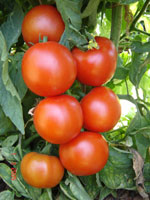




Products & Services

Products & Services ďż˝ Package of Practices



| Tomato |
 Botanical
Name: Lycopersicon esculentum Varieties: Sakthi:Bacterial wilt resistant variety. Fruits are flat round, medium sized and green shouldered. Susceptible to cracking. Mukthi:Bacterial wilt resistant variety. Fruits are flat round, medium sized, whitish green without green shoulders. Susceptible to cracking. Heat tolerant variety. Anagha:High yielding.Reddish, round, medium-sized and slightly acidic fruits. Resistant to bacterial wilt.Tolerant to leaf curl and mosaic diseases, and resistance to both radial and concentric fruit cracking. It is free from green shoulder. Vellayani Vijay: Resistant to bacterial wilt. Climate & Soil: It is a warm season crop. The best fruit colour and quality is obtained at a temperature range of 21-24°C under bright sunshine.The plants cannot withstand frost and high humidity. It requires a low to medium rainfall. It can be grown on a wide range of soils from sandy to heavy clay. However, well-drained, sandy or red loam soils rich in organic matter with a pH range of 6.0-7.0 are considered as ideal. Season: Sow the seeds during September and transplant the seedlings during October-November for an irrigated crop. If rain shelters are provided planting can be done in May- June also. Seed rate: 400gm/ha Seed Treatment: Treating the seeds with Thiram @ 3g per kg of seeds will prevent the seed born fungal diseases. Spacing: Seeds are sown in the nursery and one-month-old seedlings are transplanted to the main field at a spacing of 60X60 cm.For spreading varieties provide wider spacing of 75-90 x 60 cm. Nutrient management : Apply well rotten farm yard manure / compost @ 20-25 t/ha at the time of land preparation and mix well with the soil. A fertilizer dose of 75:40:25 kg N:P2O5:K2O / ha may be given. Half the dose of nitrogen, full phosphorus and half of potash may be applied as basal before transplanting. One fourth of nitrogen and half of potash may be applied 20-30 days after planting. The remaining quantity may be applied two months after planting. Crop Management: Transplanted seedlings may be given temporary shade for three to four days during hot days.Stake the plants if necessary. Pest Management :
Yield: 20 - 25 t/ha Post Harvesting: For long distance transport, the fruits are harvested at the mature green stage when the cream colour starts at the bottom. Tomatoes for local and near by markets are harvested at the breaker or ripe stage when the blossom end turns pinkish or reddish. At the fully ripe stage, the surface is pink or red and this is suited for canning purposes. The fruits are to be cleaned, sorted and graded. The fruits are then packed in wooden boxes or cartons. Seed Collection: |
| |